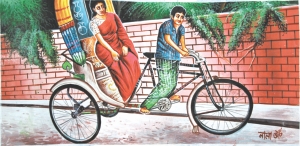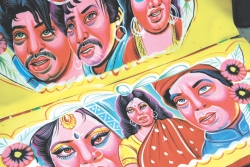| Home - Back Issues - The Team - Contact Us |
 |
| Volume 11 |Issue 03| January 20, 2012 | |
|
|
Lifestyle A Moving Canvas Sushmita S Preetha The artist dips his paintbrush in neon green enamel paint, his eyes squinting against the rays of the sun. He pauses for a moment, contemplating if the neon was, indeed, the right choice – if it would aptly capture the evil yet mysterious nature of the smirking villain. It's not ominous enough, he decides, and with a heave of sigh, he puts his brush away.
Like all good artists, he is very particular about his work. But his canvas is unlike that of all others. Manik Talukdar, 68, is a richshaw painter. Considered by mainstream society as a labourer and at best as an artisan, Talukdar is an artist whose meticulously drawn images adorn thousands of rickshaws in Dhaka city. Sadly, however, his work often gets lost amid the chaos and traffic jams of this city, and his art is almost on the verge of extinction. Rickshaw art began in the 1950s, a decade or two after the introduction of the rickshaw in the then East Pakistan. Decorative motifs were used to spice up the otherwise dull, three-wheeled vehicle. From its inception, rickshaw artists followed the bright, techno-coloured approach of the movie-billboard makers. Since then, rickshaw painting has been characterised by loud primary colours, popular motifs and a flat, one-dimensional technique that doesn't use shadows, depth or perspective. “I began my career assisting my ustaad who used to paint cinema billboards. He taught me the tricks of his trade, and I used to apply the same techniques when I began to paint rickshaws,” says Talukdar. “Some of my fellow rickshaw painters did both – they had workshops where both billboards and rickshaws would be painted.” The backboards, rear side panels, hoods and rear tin plates of the rickshaws are ornamented with a myriad of images, patterns and messages, ranging from titillating pictures of Dhaliwood actresses to pious illustrations of mosques. Some images are so popular that they have become synonymous with rickshaw art – the Taj Mahal, floral patterns, village scenes, birds, peacocks, tigers etc. “There are some common themes that everyone seems to like and so we do a lot of those, but we still try and put variations when we paint each individual rickshaw,” explains Mohammed Ujjal Hossain Hira, a young rickshaw artist. He says that sometimes he improvises and tries something bold, but whether or not he will repeat the same image depends on the feedback and reception he receives. “There is only so much freedom that we have. At the end of the day, we have to please the client,”
Some of the images in the rear tin plates of the rickshaws have a distinctly surreal feel. It's not uncommon to see representations of animals in humanoid forms: a tiger fishing in a lake, an elephant holding a meeting with a bunch of other animals, a fox using a machine or carrying a palki. Such works transgress the boundary between the real and the fantasy as familiar objects or scenes take on a mysterious and dream-like aura. Pictures of Dhaliwood are perhaps among the catchiest of rickshaw decorations. Curvy heavy-set actresses accompanied by moustached men smile, glare, meekly glance at each other or engage in bloodbath in front of us providing us visual relief as we sit stuck in traffic jams. In one such occasion, I came across a rickshaw with the “Namajer jonno asho” (Come for Prayers) placed auspiciously above a melodramatic and rather intimate scene of a scantily-clad actress beside one of our popular heroes. Blasphemy or true ebadaat, who knows? More interesting still are the images of Osama Bin Laden and Saddam Hussain popularised after the US invasion of Iraq. I recall seeing portrayals of Saddam Hussain with his palms placed as if in prayer, facing a mosque, with jet planes in the sky, with the message, “Raakhe Allah mare ke,” (Who can kill if Allah wants to protect) and that of Laden and Saddam Hussain in front of a mosque. Another rickshaw painting had the message “Jege utho go Muslim, Jihad diyeche daak, Allah'r pothe nei kono bhoy, jibon gele jaak” (Wake up, Muslims and listen to the call of Jihad, there is no fear in following the path of Allah, even if you lose your life).
But this art form is slowly but surely dying in this age of urbanisation and technological advancement. The traditional hand paintings are being fast replaced by digitally mastered pictures. The once popular workshops of the artisans have to make way for shops that allows one to print images fast and at an affordable rate. “Back in the days, I was never in want of work, but now my job is being done by a computer. I just can't compete,” says Hira, with a sigh. “The only places that still employ us are those that remain unaffected by modernity,” he adds. Artists like Hira are forced to find other means of employment to make ends meet. Gone are the days when a nicely decorated rickshaw, ornamented with appliqués of flowers and bright and quirky hand-painted images, was the king of the road. Gone, too, are the vibrant baby-taxies, which were also the canvases of these artists. Now, standardised rickshaws and unadorned CNGs, with none of the charm or the character of its predecessors, have colonised the streets of Dhaka. Some art and handicraft places have, over the years, sought to bring rickshaw art to the forefront of mainstream aesthetics. Jatra, for one, with branches in Dhanmondi and Gulshan, has popularised rickshaw art among the urban elite and foreigners. Artists, photographers, and cultural anthropologists, both at home and abroad, have begun to notice this unique tradition and appreciate it as a genre-defining form of art. But unless something is done about the shrinking space of expression of these artists, rickshaw art may well soon become a relic of our cultural heritage.
Copyright
(R) thedailystar.net 2012 |
||||


 Largely ignored by the urban well-off populace, these diverse works depict the views, aspirations, fantasies and aesthetic impressions of the urban poor. The images and their meanings are fluid and context-specific, influenced by time, space, our cultural heritage and history. But they are also a way for the 'subaltern' to showcase their artistic and creative potential that have no other means of expression. It is people's art in its truest form, unhindered by bourgeois notions of aesthetics and pleasure.
Largely ignored by the urban well-off populace, these diverse works depict the views, aspirations, fantasies and aesthetic impressions of the urban poor. The images and their meanings are fluid and context-specific, influenced by time, space, our cultural heritage and history. But they are also a way for the 'subaltern' to showcase their artistic and creative potential that have no other means of expression. It is people's art in its truest form, unhindered by bourgeois notions of aesthetics and pleasure.